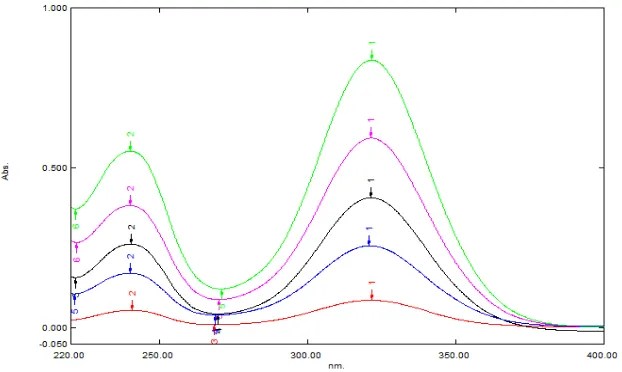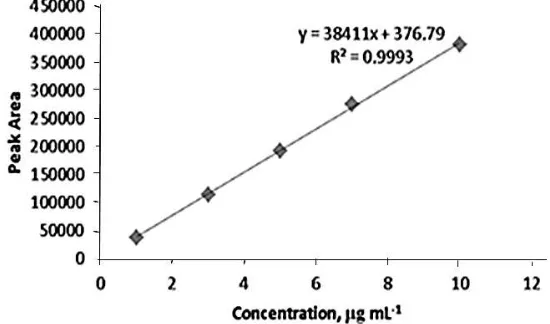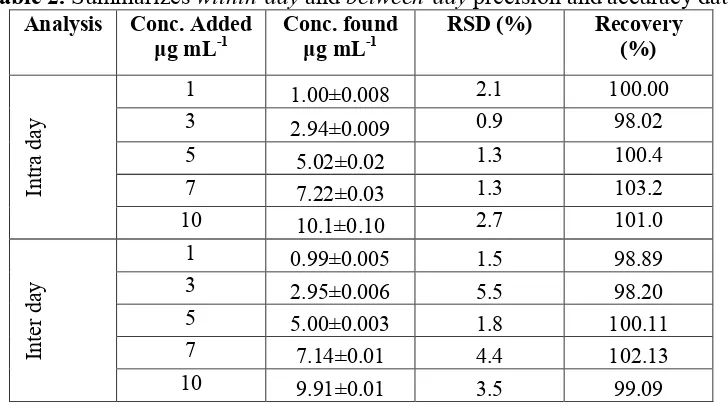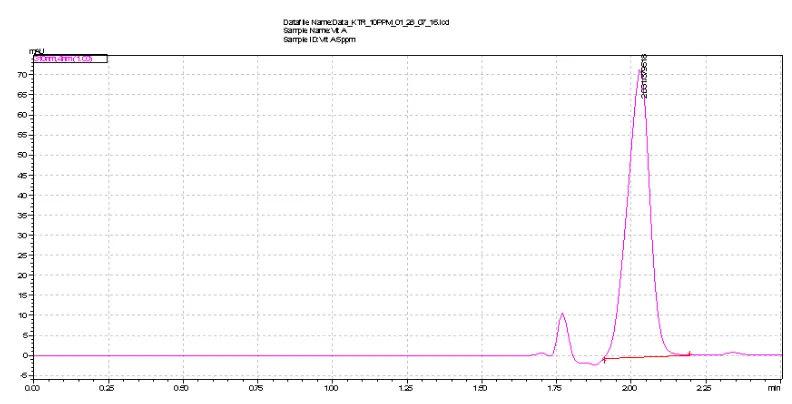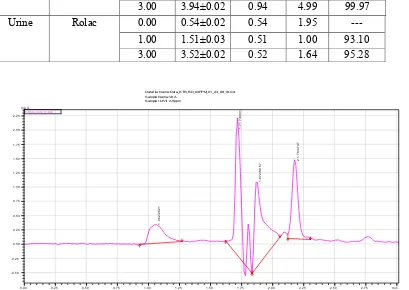The journal homepage www.jpacr.ub.ac.id
p-ISSN : 2302 – 4690 | e-ISSN : 2541 – 0733
Estimation of ketorolactromithamine in Phamaceutical samples
and biofluids by the new validated UPLC method
Mohammad Nasir Uddin1*, Monir Uddin1, Md. Touhid Kabir1, Suman Das2
1
Department of Chemistry, University of Chittagong, Chittagong-4331, Bangladesh. 2
BCSIR Laboratories, Chittagong, Bangladesh.
*Corresponding author: [email protected]
Received 19 January 2017; Accepted 27 April 2017
ABSTRACT
A new UPLC method has been described to determine ketorolac tromethamine in pharmaceutical samples and biofluids. Drug was eluted using a reversed-phase Gemini 3U, C18, 110R (150 × 4.6 mm, 3 μm) column when a mobile phase composition 90:05:05 (v/v) consisting CH3OH, CH3CN and NaH2PO4 under isocratic program. Ketorolac tromethamine was eluted at a short of time 2.02 min. Ketorolac tromethamine isolated from biofluids after liquid-phase extraction. The results were linear up to 10 µg mL-1 with the correlation coefficients greater than 0.999. The sensitivity limits, LOD and LOQ were 0.016 and 0.051 µg mL-1, respectively. The method is simple, fast and reliable with good specificity and sensitivity and will be suitable for routine analysis of ketorolac tromethamine.
Keywords : Ketorolac tromethamine, pharmaceutical samples and biofluids, UPLC method
INTRODUCTION
pre-operative analgesia or co-administration with anesthesia because it inhibits platelet aggregation and thus may be associated with an increased risk of bleeding[5,6]. Ketorolac is not recommended for long-term chronic pain patients. However, ketorolac has been co-administered with meperidine and morphine without apparent adverse effects on patients. As with all NSAIDs, ketorolac should be avoided in patients with renal (kidney) disfunction. The patients at highest risk, especially in the elderly, are those with fluid imbalances or with compromised renal function e.g., heart failure, diuretic use, cirrhosis, dehydration, and renal insufficiency.
Figure 1. Structural formulae for ketorolactromethamine (MW=376.4)
Ketorolac causes serious side effects including heart attack, stroke, high blood pressure, heart failure from swelling (fluid retention), kidney problems including kidney failure, bleeding and ulcers in the stomach and intestine, low red blood cells (anemia), life-threatening skin reactions, liver problems including liver failure, asthma attacks in people who have asthma [7,8]. Other side effects are stomach pain, constipation, diarrhea, gas, heartburn, nausea, vomiting, and dizziness. Since this drug is widely seen in clinical cases, the measurement in samples continues to be of concern and investigation.
In this regard a single, rapid, reliable method with high precision is immense important for the analysis of ketorolac. Though several chromatographic methods have been developed for the determination of KTR by means of HPLC/UV [2, 9-15] or HPLC-MS [16]; some of these methods have a limit of quantification (LOQ) that is too high, some require length analysis times or long time for treatment sample. However, GC-MS [17] or LC-MS/MS [16] is a promising tool for analysis of drugs but suffers from a major limitation of involvement of tedious, time consuming and expensive instrumentation. There has been much emphasis recently, on reducing analysis time and solvent consumption in HPLC. The advances in column technology and the introduction of a number of commercially available ultrahigh performance liquid (UPLC) chromatographs, has permitted this reduction. This improvement in speed and sensitivity is useful in all areas of the pharmaceutical process. Therefore, the objectives of the research are to develop a simple and sensitive UPLC method for the estimation of ketorolactromethamine in pharmaceutical formulation and biofluids after optimized liquid-liquid extraction.
EXPERIMENT
Materials and Methods Instruments
Chemicals
HPLC-grade methanol was supplied by SIGMA-ALDRICH (Germany), ACN was supplied by Scharlau (Scharlab S. L., Spain) and sodium dihydrogen phosphate was supplied by Applichem GmbH (Germany). Water used throughout the study was purified by the reverse osmosis method to gain high-purity water with a Milli-Q water purification system from Millipore (Millipore, Bedford, MA, USA). Purity of reference compounds was not less than 98%. Pharmaceutical formulations commercially available in Bangladesh were analysed to check the applicability of the method.
Preparation of standard
Stock solutions of the anions (1000 mg L−1) were prepared by dissolving an appropriate amount of KTR in a volumetric flask and diluting to the mark with water. Experimental solutions were prepared by appropriate dilution of the stock solutions.
Sample Preparation Pharmaceutical Samples
Twenty tablets or the content were finely ground and powdered. An accurately weighed portion equivalent to 100 µg mL-1 solution for each compound, was transferred to volumetric flask, dissolved and diluted up to the mark with ethanol. The solution was sonicated for 15 min and centrifuged at 3000 rpm for 10 min, and filtered through a 0.22 μm PTFE syringe filter with Whatman filter paper. An aliquot portion was transferred to volumetric flask, diluted with ethanol as to provide a stock solution of 100 µg mL-1. All stock solutions were stored at 4oC in refrigerator. Dilution has been made to accurately measured aliquots of the stock solution with ethanol to give working concentrations of the analyte.
Blood samples
0.5 mL upper layer of the blood were taken in three vial, 0.5 mL acetonitrile were added into three vial ,for blank solution 1 mL ethanol were added into a vial and 1 mL of 1 µg mL-1 & 3 µg mL-1 standard solution were added into remaining two vial. The solution was sonicated for 15 min and centrifuged at 3000 rpm for 10 min, and filtered through a 0.22 μm PTFE syringe filter with Whatman filter paper. All solutions were stored at 4oC in refrigerator.
Urine Samples
1 mL of Urine were taken in three vial ,for blank solution 1 mL ethanol were added into a vial and 1 mL of 1 µg mL-1 & 3 µg mL-1 standard solution were added into remaining two vial. The solution was sonicated for 15 min and centrifuged at 3000 rpm for 10 min, and
filtered through a 0.22 μm PTFE syringe filter with Whatman filter paper. All solutions were
stored at 4oC in refrigerator.
Chromatographic conditions
A standard solution at concentration level 5 μg mL-1
optimized conditions at a flow rate of 0.20 mL/min at ambient temperature. An UV scan of standard solution was done for the spectra of studied drugs in the range of 250 to 400 nm to detect the absorption maxima Figure 2. The best flow rate was investigated with respect to
sharpness and symmetry of the peaks. The injection volume was 10 μL. Prior to the analysis
the column was equilibrated with mobile phase. The dihydrogen sodium phosphate solution was filtered in vacuum using 0.2 µm membrane, and the mobile phase was degassed prior to use by a stream of helium.
Figure 2. Electronic spectra of ketorolac standard solution in the used mobile phase
Preparation of calibration curve
Calibration curves were prepared for five concentration levels of the analyte ranging from 1.0-10.0 µg mL-1 when peak area was plotted against theoretical concentrations. Curve was fitted by a least squares linear regression to the equation, y = mx + c. Where, y = response ratio, m = slope, x=concentration of analyte and c = intercept. Calibration equation so obtained was used to find the unknown concentration of the analyte.
Validation Parameters
Validation parameters ; precision, accuracy, specificity, limit of detection, limit of quantitation, linearity and range, suitability and robustness as recommended by the ICH [18] were investigated for checking the analytical performance of the method.
RESULTS AND DISCUSSION Chromatography
The chromatographic conditions optimized were composition of the solvents, and mobile phase flow rate. Mobile phase it must elute all the different substances with satisfactory peak shape and in a short time. Initial experiments with the LC system using methanol or acetonitrile as organic modifier in the buffered mobile phase were performed for better separation of analytes. The combination of methanol with 5mM dihydrogen sodium phosphate served our intentions best. Reversed-phase Gemini 3U, C18, 110R (150 × 4.6 mm,
3 μm) column and 5 mM NaH2PO4 as buffer solution all through the experiment were used
maximum absorption wavelengths ranged between 270 and 360 nm. Therefore, 310 nm selected for monitoring as compromised to the drug. To determine the optimum mobile phase flow-rate under optimized composition the effect on Rt, peak height and peak width was studied. As expected when the mobile-phase rate was increased Rt decreased. A flow-rate of 1 mL min-1 was chosen as a compromise analysis time, because this value also maintains good peak shape. The mobile phase mixture of CH3OH, CH3CN and 5mM NaH2PO4 by the composition of 90:05:05 (v/v) was optimized at isocratic program (Table 1). The method was carried out for the detection and quantitation of the drug representing total elution time less than 2 min (2.03±0.005 minutes). A representative chromatogram as shown in figure 3 was obtained from a standard solution under optimized conditions. No interfering of peaks was observed in the samples studied. Precision of retention times was examined to evaluate system suitability from within-day repeatability (mean value of six measurements, n = 18) and between-day precision (mean value of three measurements during six days, n = 54)
at 1, 2, 3, 4, 5 and 10 μg mL-1
level of drugs, which revealed RSD values of 2.57%.
Table 1. Optimum isocratic program for the proposed method
Program Time
*Program has been followed throughout the experiment
Figure 3. Typical UPLC chromatogram of the examined drug (10 μg mL-1) in standard.
Chromatographic conditions are described in text. Peaks: 2.031 min (KTR).
Method Validation
The described UPLC method was developed using a simple mobile phase to provide a rapid quality control determination of both drugs in standard and pharmaceutical formulations. The parameters linearity, selectivity, extraction recovery, precision, accuracy, stability and robustness were studied for the validation of the method
Linearity
The calibration curves constructed for standard using working concentration at levels
1.0, 3.0, 5.0, 7.0, 10.0 μg mL-1
of ketorolac. Calibration curves were constructed using peak area of drug versus nominal concentrations of the analyte. Calibration equations are y=38411x+376.79 for KTR determination. The calibration curves were linear in the range of
01-10 μg mL-1 for KTR. The coefficients of determination (r2) were 0.9999 for the drug.
Figure 4 show the calibration curve for the determination of ketorolac.
Figure 4. Calibration curve for the determination of ketorolac
Sensitivity
The limit of detection were calculated from calibration graph by the formula;
LOD=3•Sxy/a, and the limit of quantification; LOQ=10•Sxy/a. The LOD and LOQ were
found to be 0.016 and 0.051 μg mL-1
, respectively. These results indicate that method is sensitive enough for therapeutic assay.
Recovery/Accuracy
Table 2. Summarizes within-day and between-day precision and accuracy data
Analysis Conc. Added μg mL-1
Conc. found μg mL-1
RSD (%) Recovery
(%)
In
tr
a
d
ay
1 1.00±0.008 2.1 100.00
3 2.94±0.009 0.9 98.02
5 5.02±0.02 1.3 100.4
7 7.22±0.03 1.3 103.2
10 10.1±0.10 2.7 101.0
In
te
r
d
ay
1 0.99±0.005 1.5 98.89
3 2.95±0.006 5.5 98.20
5 5.00±0.003 1.8 100.11
7 7.14±0.01 4.4 102.13
10 9.91±0.01 3.5 99.09
Precision
The relative standard deviations (RSD) obtained for the within-dayassay at five concentrations (n=5) in the range 0.9-2.7% for KTR and for Between-day assay the corresponding values in the range 1.5-5.5% for KTR indicating the high precision of the method. Within-day and between-day precision data for proposed method are presented in Table 2.
Specificity/Selectivity
The specificity was demonstrated showing that drug was determined free of interference from potential impurities and degradation products by the absence of any peak in the same retention times.The selectivity of the method was checked by injecting ketorolac tromethamine standard solution, background control sample. There was no interference at retention time of ketorolac due to back ground control sample.
Figure 5.Typical UPLC chromatogram of the examined drug (10 μg mL-1) in pharmaceutical formulation. Chromatographic conditions are described in text. Peaks: 2.031 min (KTR).
Robustness
It was found that the percent recoveries were excellent under most conditions, and remained unaffected by small deliberate changes of experimental parameters including the flow rate and isocratic program (Table 1) though retention time and resolution was shortened as expected. There was no noticeable difference between the chromatograms when the wavelength was varied by ±3 nm. Variation in the experimental parameters (flow rate, isocratic program) provided an indication of its reliability during normal use and concluded that the method was robust as shown in Table 3.
System Suitability
A system suitability test was an integral part of the method development to verify that the system is adequate for the analysis of KTR to be performed. The system suitability was assessed by replicate injections (n=5) of the sample at 5 µg mL-1 concentration level including within- and between-day assessments for standard. Precision of retention time and peak area was examined to evaluate the system suitability. RSD of the peak area 0.63% and that of retention time 0.85% indicates excellent suitability of the system as shown in Table 3.
Table 3. Validation parameters in terms of suitability and robustness
Conc.
(5 µg mL-1)
Suitability Robustness
R (%)
R.T. (n=5) Area(n=5)
Average 2.031±0.005 516845±0.03 99.75
RSD (%) 0.85 0.63 1.25
Stability
The stability of KTR in methanol, stored in clear glassware in the fridge (4ºC) was tested at five intervals by the 30 days. The responses from the aged solutions were compared with those from freshly prepared standard solution. The results showed that the retention time and peak area of KTR remained almost unchanged and no significant degradation within the
indicated period occurred. Recovery of the compound was ≥ 99 % up to one month at 4°C
the possibility of using the samples over a period of 30 days at refrigerator without degradation. This indicates good stability.
Figure 6. Long term stability graph for ketorolac
Column Efficiency
The column efficiency parameters have been calculated for a representative chromatogram. This test is essential for the assurance of the quality performance of a chromatographic system. The calculated values ; retention factor, k = 0.733±0.03, theoretical plate number, 763±5, and tailing factor, Tf = 1.36±0.01 shown in Table 4 revealed the excellent performance of analytical column.
Table 4. Validation parameters in term of column efficiency
Efficiency NTP HETP T. F C.F, k´
Average 763±5 203±1.4 1.36±0.01 0.733±0.03
RSD (%) 0.69 0.72 0.37 0.37
Degradation kinetics
Rate constant of degradation can be determined by plotting log(a-x) after definite time interval, t (days) when a straight line with negative slope is obtained (Figure 7) indicating that degradation followed first order kinetics having the rate constant, k value of 0.0003 day-1.
Where, ‘a’ is the initial concentration and ‘x’ is the degraded concentration after definite time
interval.
Applications
Application to Pharmaceutical formulation
The method developed here was applied to various concentrations (3.0, 5.0 µg mL-1) of solutions prepared from pharmaceutical products for determining the content of KTR.
Typical UPLC chromatogram of the examined drug (5 μg mL-1
) in formulation is given in Figure 6. Typical UPLC chromatogram of the examined Blood sample with (3 μg mL-1 KTR) is given in Figure 8. Typical UPLC chromatogram of the examined Urine sample with
(3 μg mL-1
KTR) is given in Figure 9. The values of the overall drug percentage recoveries and the RSD values of measurements are as presented in Table 5. Determination was free of interference from degradation products and no interference from the sample excipients could be observed at this detection wavelength, indicating the high specificity of the method. Results indicate that measurements are acceptable with good precision. Recovery was almost same as that of leveled values for four tested samples. Some contain excessive large amount and some contain lower than labeled values. It is may be due to lack of proper quality management.
Table 5. Determination of ketorolac in pharmaceutical formulation, blood sample and urine
samples by the proposed method
Brand Manufacturer Conc. μg mL-1 RSD (%) Recovery
(%)
Average R (%)
Tablet Added Found
Etorac INCEPTA 3 2.28±0.007 0.008 76.19 75.33
5 3.78±.05 0.35 74.46
Ketonic SK+F 3 1.86±0.1 2.43 62.20 61.96
5 3.08±0.08 0.67 61.72
Rolac RENATA 3 1.98±0.02 0.31 66.17 66.15
5 3.30±0.04 0.32 66.14
Xidolac BEXIMCO 3 2.50±0.008 0.09 83.43 85.13
5 4.34±0.01 0.07 86.83
Torax SQUARE 3 2.05±0.1 1.43 68.37 67.40
5 3.32±0.03 0.22 66.44
Injection
Torax SQUARE 3 2.33±0.1 1.25 77.82 76.95
5 3.80±0.08 0.59 76.07
Rolac RENATA 3 1.63±0.06 0.95 54.46 54.33
5 2.71±0.007 0.07 54.20
Application to Bio-samples
Table 6. Determination of ketorolac in blood and urine sample by the proposed method
Figure 8.Typical UPLC chromatogram of the examined blood sample spiked with 3 μg mL-1
KTR, Peaks: 2.178 min
Figure 9.Typical UPLC chromatogram of the examined urine sample spiked with3 μg mL
CONCLUSION
For the determination of KTR in biofluids, UPLC method presented herein meets the criteria for routine therapeutic drug monitoring or pharmacokinetic studies. The advantage of the method over previously reported methods is the rapidity, simplicity (ease of sample preparation), high sensitivity, and high selectivity. The LOD and LOQ achieved make the assay appropriate for the measurement of therapeutic concentrations. Stability studies showed that the samples can be stored without degradation for a period of up to 7 days. Furthermore the lower solvent consumption along with the significantly reduced run time leads to an environmentally friendly economically analytical procedure that allows for the analysis of a large number of samples over a short period of time.
REFERENCES
[1] Rang H, Dale M, Ritter J and Flower R, Pharmacology, 6th Ed., Churchill Livingstone, Elsevier, 2007, 227-230.
[2] Wang Z, Dsida R., and Avram M. J., J. Chromatogr. B, 2001, 755(1-2), 383-386. [3] Warner T. D., Mitchell J. A., FASEB J, 2004, 18, 790-804.
[4] Galán-Herrera J. F., Poo J. L., Maya-Barrios J. A., de Lago A., Oliva M. S. I., . Mario González-de la P., Patricia J., Ericka L., Victoria B., Salvador N., Clin Ther, 2008, 30, 1667-1674.
[5] Dave, J. B., P. J. Vyas, C. N. Patel, Chron. Young Sci., 2013, 4(1), 24-31.
[6] Martindale, The Complete Drug Reference, 35th Edition, 2004, London, Pharmaceutical Press.
[7] Committee on the Safety of Medicines and Medicines Control Agency, Curr. Prob. Pharmacovigilance, 1993, 19, 5-8.
[8] Strom BL, Berlin JA, Kinman JL, Spitz PW, Hennessy S, Feldman H, Kimmel S, Carson L, JAMA, 1996, 275, 376-82.
[9] R Singh, APathak, P Chawla, Indian J. Pharm. Biol. Res.,2013, 1(4), 95-101.
[10] Bhagyashree R. D., K. P. Bhusari, M. R. Tajne, M. H. Ghante, N. S. Jain, Indo American Journal of Pharm Research., 2014, 4(7), 3248-3257.
[11] Razzaq S. N., Khan I. U., Quim. Nova., 2012, 35(6), 1216-1221.
[12] Jayant B. Dave, Pratik J. Vyas, Chhagan N. Patel, Chron. Young Sci., 2013, 4(1), 24-31.
[13] Chaudhary R, Gangwal S, Jindal K and Khanna S, J. Chromatogr. B, 1993, 614(1), 180-184.
[14] Jones D and Bjorksten A, J. Chromatogr. B, 1994, 661(1), 165-167.
[15] M. N. Uddin, S. Das, S. H. Khan, S. K. Shill, H. R. Bhuiyan, R. Karim, J Taibah Univ Sci,2016, 10(5), 755-765.
[16] Patri, S., A. K. Patni, S. S. Iyer, A. H. Khuroo, T. Monif, S. Rana, S. Kumar, and R. Jain, Chrom. Res. International, 2011, 2011, 1-11.
[17] Logan, B. K., Friel, N. P., Peterson, K. L., Predmore, B. B., J. Anal. Toxicol., 1995, 19, 61.

